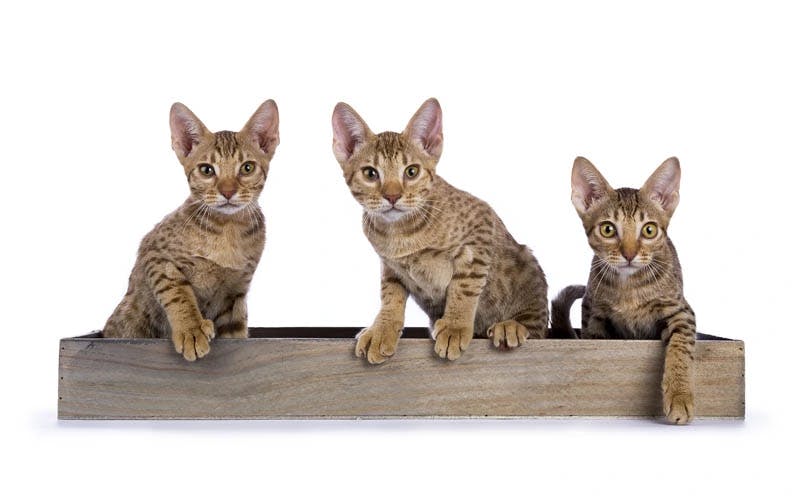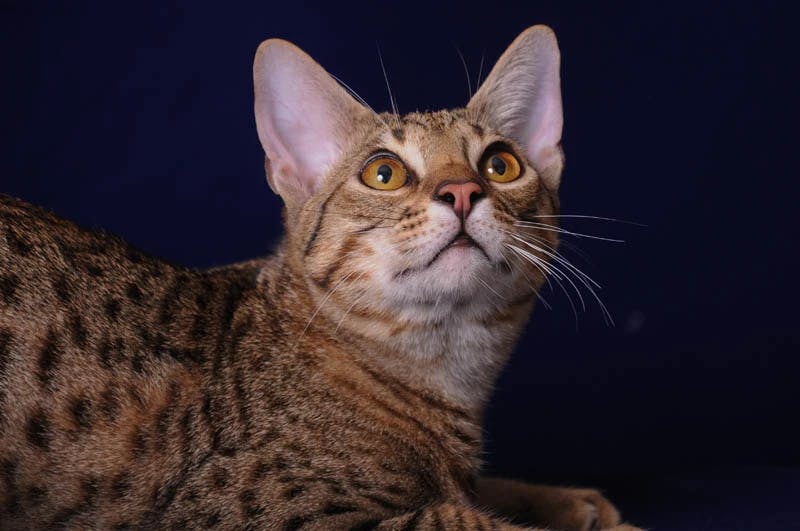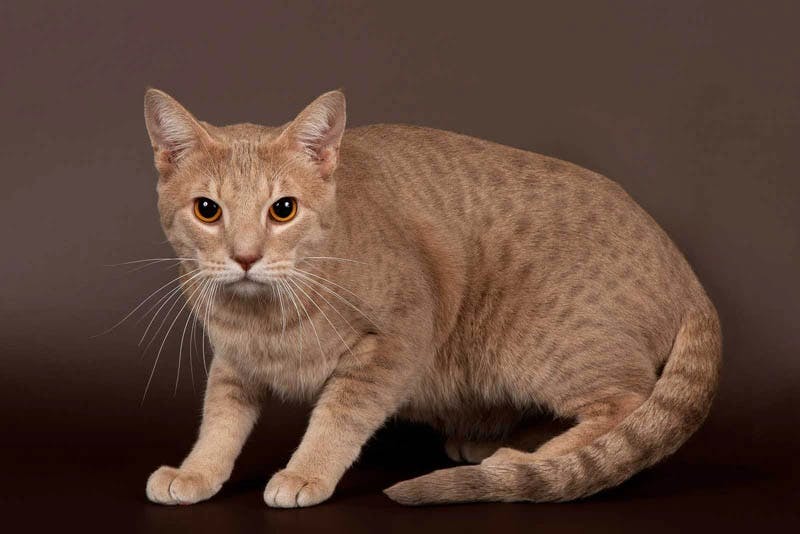Ocicat
A Domestic Cat that Looks Like an Ocelot
Ocicat
Antonia Cirjek - Last Updated on December 18th, 2021
Things you Should Know about the Ocicat
The Ocicat cat can fulfill any cat lover’s dream of having a wild cat as a companion. There is something appealing about the power, size, grace, and beauty of wild cats. Naturally, they would be impossible to keep as pets, so no one does.
However, the Ocicat was created as an answer to that dream.
Ocicats look like wild cats because of their spots, but they are actually domestic cats. It is a breed that was developed by using Abyssinian, Siamese, and American Shorthair cats.
Similar to the mentioned breeds, the Ocicat is a talkative, self-confident, and extremely active cat. It is the perfect pet for those that prefer their pets to be a bit wilder.

Appearance Matters. What does an Ocicat look like?
Ocicat cats have what is best described as a wild appearance. They are mighty and athletic but still remain graceful. These cats are known for their spotted appearance.
The Ocicat size is medium to large, and they have substantial muscle and bone development. They normally weigh much more than you would think by their size. Their ribs are slightly sprung, so they have some depth of chests, and their back is slightly higher in the rear.
The legs of an Ocicat have strong muscles and good substance. They are medium-long, extremely powerful, and their size is proportionate to the body. Their feet are compact and oval and have five toes in the front and four in the back.
The ears are moderately large and alert and are set to corner the upper outside parts of the head. The ears are generally not placed too high or too low and sit at a 45-degree angle. Some Ocicats are known to have ear tufts that extend vertically from the tips of their ears.
What colors do the Ocicat cats come in?
Ocicat cats can come in one of six colors that can also appear on a silver base, making it 12 altogether.
Here are the six main colors:
- Tawny
- Chocolate
- Cinnamon
- Blue
- Lilac
- Fawn
The part of their faces around the eyes usually has the lightest color, as well as their chins and lower jaws. You can find the darkest color on the tip of the tail.
What is the difference between a Bengal cat and an Ocicat?
When it comes to the Ocicat vs. Bengal argument, there are some differences between the two.
Bengals are generally bigger and weigh more. Also, they have a bump on the back of their neck, between the shoulders, that the Ocicats do not have.
Their fur might seem similar at first, but the Bengal cat’s pelt resembles a rabbit’s fur more. Ocicats have smooth, tight fur.
There is also an Ocicat Bengal mix that is known as the Cheetoh cat. However, they are still not recognized as a pedigree breed.

It's all Personal. The Ocicat Temperament
The Ocicat personality is affectionate and curious. They are adaptable cats that attach themselves to their human companions strongly. They may look wild and are quite playful, but they will enjoy peaceful times with you as well.
These cats are social, active, and extremely intelligent. They will learn to respond to their name quickly, and you can teach them a variety of tricks. They can easily be taught to come on command. They will also learn how to beg for food all by themselves.
Ocicat kittens will normally bond with only one person and generally prefer that person’s company to any other. Still, they will be friendly to other people in the household.
These cats can get along well with other animals and people and will appreciate other animal companions. They will enjoy their company, especially if you leave them alone for some time.
Ocicat’s ancestors are Abyssinians, and just like them, Ocicats will perform small tap dances for your amusements. They are highly active and require a lot of space and many toys that will keep them occupied.
They can also be vocal but are never annoying. These cats will love to talk to you and tell you about their day but won’t bore you to death with it. They have a nice voice that most won’t find irritating.
Still, they are tuned to the tone of your voice. This is why you should never verbally harshly reprimand them. They will notice, and it might damage the trust they placed in you.
Can Ocicats be left alone?
Ocicats are extremely devoted to their owners and don’t like being left alone, especially for longer periods.
This is why you should consider getting a feline companion for them. It would be best if it was another Ocicat. They will get along with other cats with no issues.
Caring for your Ocicat
Grooming the short coat of these cats is quite simple. They don’t shed much, so brushing it once a week should be more than enough. You should rarely bathe them, and if you do, use a cat shampoo that will enhance their coat color.
The Ocicat is not hypoallergenic. Its shedding is minimal but still present, so avoid them if you’re suffering from allergies.

The Health and Happiness of your Ocicat
The Ocicat lifespan is around 15 years. They generally remain quite healthy throughout their lives. But, they can inherit some health problems that plagued their parent breeds.
Pyruvate kinase is the name of a key regulatory enzyme found in red blood cells. Cats that don’t have enough of this enzyme can develop anemia. This condition is caused by a recessive gene and can be removed from the gene pool through DNA testing.
Finally, hypertrophic cardiomyopathy is known as the most prevalent form of heart disease in cats. This condition causes the thickening of the heart muscle. You can confirm whether a cat suffers from this condition through an echocardiogram.
Where Can I Find Reputable Ocicat Breeders?
Ocicats look like wild cats but are actually domestic, so you should be able to find breeders relatively easily.
If you want one of these feral-looking kittens, take a look at our list of Ocicat breeders. There you should be able to find the best breeder for you and your needs.
These cats are not cheap and can cost between $800 and $2,500, so be prepared for that. However, getting a cat from a breeder will always be more helpful in the long run.
Feline History. Where does the Ocicat come from?
The Ocicat first appeared as a result of an accident.
It was the surprise result of a cross between a ruddy Abyssinian male and a seal point Siamese female. This happened in 1964, and the original goal was to develop a Siamese cat with some Abyssinian features. Virginia Daly was the breeder of the very first Ocicat.
She managed to breed the Siamese with Abyssinian features and repeated the process once again. This was when she noticed an unusual cat in the litter. It was ivory, with gold spots, and she named it Tonga. However, since it wasn’t what she was looking for, she sold it as a pet.
Geneticist Clyde Keeler read about it in a letter from Daly and urged her to repeat the process. This time she added American Shorthairs to the mix and got the Ocicat.
The breed was first registered by The Cat Fanciers’ Association in 1966, giving it full recognition in 1987.
